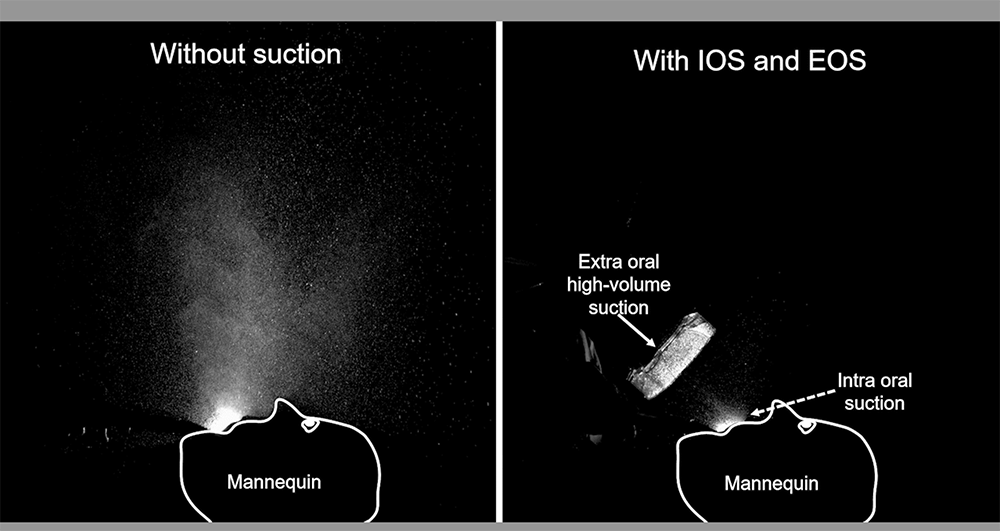Researchers in Japan Use LED Imaging to Show Oral Suction Devices’ Impact on Aerosol Reduction
Study conducted at Tohoku University determined that extraoral and intraoral suction can greatly reduce droplet and aerosol spread within the air during dental treatment.

During the pandemic, much was made of how many infectious diseases, such as COVID-19, are known to spread through aerosols and droplets suspended in the air. Concerns were obviously great in the dental industry as dentists and hygienists constantly work in an environment where aerosols and droplets are prominent.
Therefore, it was then—and still is—necessary to fully understand the hazards of aerosols and droplets presented during dental treatment. A study recently published does show plenty of promise in regard to the ability of oral suction devices to greatly reduce these harmful spreads in the air.
Using a dental air turbine and a mannequin, researchers at Tohoku University in Japan recreated the droplets and aerosols that occur during dental procedures. The key is the high-sensitivity camera and high-intensity LED light source, which allowed for high-quality images of the droplet spreading during the simulated procedure, which was previously difficult to do in real-time without dye. Then, extraoral suction (EOS) and intraoral suction (IOS) were used to determine how well these oral suction devices work. Using these techniques, the researchers reduced droplet and aerosol spread within the air by 97.8% when both EOS and IOS were used, and a 92.1% reduction using IOS alone.
The researchers published their results on February 22 in the Journal of Prosthodontic Research.1
"Since the droplets and aerosols ("spray" and "mist") generated during dental treatment contain bacteria and viruses derived from saliva and blood, elucidation of their spreading and diffusion dynamics is required from the perspective of COVID-19 prevention," Jun Watanabe, author and researcher at Tohoku University, says in a press release. And saliva is not the only component that can aerosolize and cause issues either. Different materials can produce different aerosols; silicon, calcium, potassium, and zinc have been recorded in air samples from dental clinics. Inhalation of fine dust, mainly silica, can lead to respiratory issues in frequently exposed individuals. Understanding the spread and diffusion of such particles in the air is a key step in successfully protecting individuals from potentially harmful diseases that can be spread through airborne droplets.
Reduction of aerosol droplet dispersion by the combination of intraoral suction (IOS) and extraoral suction (EOS). Photos courtesy of 2023 Japan Prosthodontic Society.

It's also worth noting that the work being done on the patient can alter the directionality or spread of the droplets. For example, researchers found that treatments for cavities on the anterior teeth are the most likely to be associated with droplet spreading. Furthermore, the correct placement of the oral suction devices is important, with the most effective positioning of the EOS device found to be about 10 centimeters away from the patient's mouth at a 0º angle.
"Analysis in various clinical situations is expected to elucidate the dynamics of dental treatment-derived droplets and aerosols and lead to the establishment of new dental treatment protocols, the development of air purification equipment, and the development of a cleaner and safer dental care environment," says Hiroyasu Kanetaka, author and researcher at the Liaison Center for Innovative Dentistry at Tohoku University.
While this study confirmed the effectiveness of IOS and EOS at reducing droplets in the air during dental treatment, some limitations will require future testing. The mannequin could not simulate breathing or exhalation, which may produce differing results. Moreover, the mannequin's lack of accurate lip and tongue morphology could also have impacted some results. The researchers state that further investigations using a patient model will be required to clarify the efficacy of these oral suction devices, but this study shows these devices can indeed have a positive impact on droplet reduction during treatments in dental practices.
Reference
1. Jun Watanabe, Yoko Iwamatsu-kobayashi, Kenji Kikuchi, Tomonari Kajita, Hiromitsu Morishima, Kensuke Yamauchi, Wataru Yashiro, Hidekazu Nishimura, Hiroyasu Kanetaka, Hiroshi Egusa. Visualization of droplets and aerosols in simulated dental treatments to clarify the effectiveness of oral suction devices; Journal: Journal of Prosthodontic Research, DOI: 10.2186/jpr.JPR_D_23_00013.
Product Bites – January 19, 2024
January 19th 2024Product Bites makes sure you don't miss the next innovation for your practice. This week's Product Bites podcast features new launches from Adravision, Formlabs, Owandy Radiology, Henry Schein Orthodontics, Dental Creations, and Dental Blue Box. [5 Minutes]